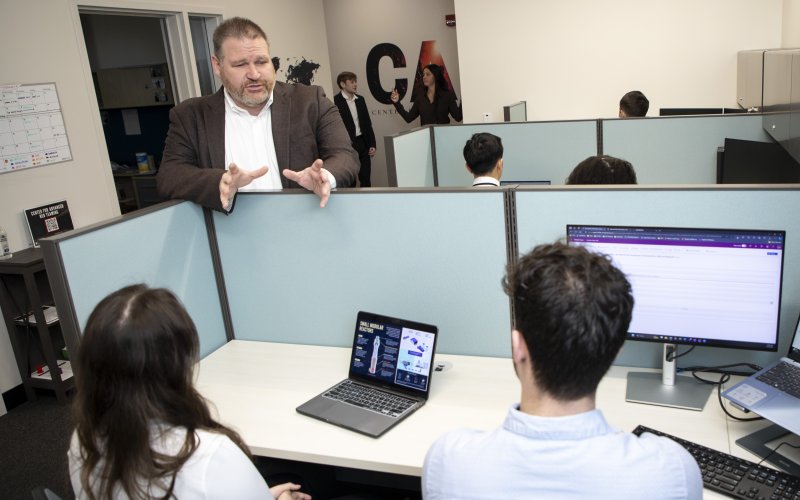CEHC Researcher Aims to Improve Global Security of Small Modular Reactors

By Mike Nolan
ALBANY, N.Y. (Feb. 29, 2024) — Small modular reactors (SMRs) are transforming the nuclear power industry. A fraction of the size of a conventional nuclear reactor, SMRs produce a large amount of low-carbon electricity — up to 300 megawatts, enough to power about 150,000 homes. The technology has the potential to make nuclear power plants quicker, cheaper to build, and safer to operate.
With a rapidly growing global interest, Brandon Behlendorf wants to ensure SMRs do not fall into the wrong hands.
Behlendorf, an assistant professor at the College of Emergency Preparedness, Homeland Security and Cybersecurity (CEHC), is leading a new research project focused on identifying gaps and challenges in SMR regulation and export controls.
Funded by The Stanton Foundation, a private foundation whose aims include nuclear security, the year-long project seeks to examine the risks to export control that still-developing SMR technology will play for the next several decades.
“SMRs are poised to be the nuclear technology of the future. The rapid global interest and development of SMRs has raised concerns about potential misuses of this technology,” said Behlendorf, who is part of CEHC’s Department of Emergency Management and Homeland Security.
“Although SMRs have unique characteristics that can make them more resistant to proliferation, these risks still need to be carefully managed. Ensuring that the technology does not fall into the wrong hands is crucial for global security.”
A Safe Nuclear Energy Future
To assess these risks, the project will first conduct an assessment of countries interested in developing and/or acquiring SMR technologies. With over 80 designs currently underway, and more than 30 countries already interested in their use, this assessment will help identify where proliferation risks could emerge.
Second, the project will evaluate the export control systems of these interested countries, capturing the extent to which SMRs are discussed in dual-use technology regulations.
These two efforts will be combined in a gap analysis that identifies existing export control vulnerabilities in regulating the global transfer of SMR technology, especially for countries interested in acquiring the new technology.
“By conducting a comprehensive examination of the issues and vulnerabilities associated with the upcoming global trade in SMR technology, we will be able to provide tailored insights and recommendations to governments, international organizations and industry associations,” Behlendorf said.
Advanced Red Teaming
Following the analysis, Behlendorf plans to collaborate with export control and SMR technical experts to run a red teaming exercise that further explores gaps and how adversaries might leverage them.
Launched in 2019, UAlbany’s Center for Advanced Red Teaming (CART) is a global leader in building the art and science of red teaming, a tactic used to understand adversarial behavior and test security processes in a wide range of industries. Behlendorf serves as the Center’s director, and with founding director Gary Ackerman, associate professor at CEHC, has delivered exercises across four continents to government stakeholders and industry leaders.
“Our red teaming exercise will aim to determine how gaps in the export controls regulating SMR technologies could potentially be exploited by adversaries,” Behlendorf said. “The outcomes will serve as an important source to inform policy decisions for a number of agencies around the world.”
Working alongside CART Research Associate Jenna LaTourette, the project will also involve student researchers from across the University.




